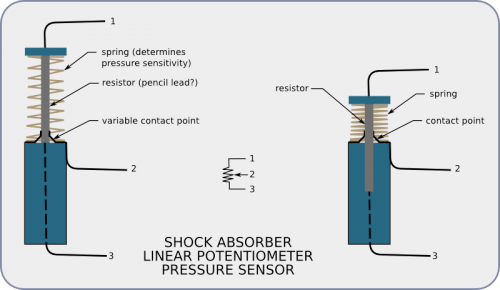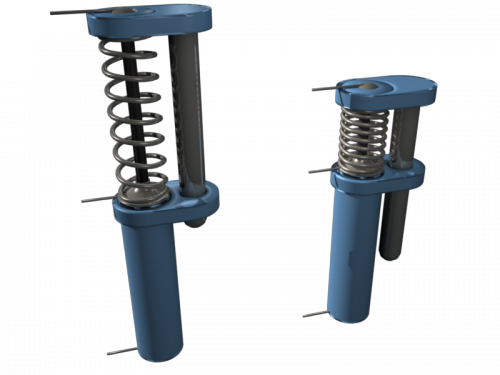I've already been 'bitten' a couple of times by waiting too long to write about things, so I'm going to try to post about things when they come to me.
Anyway, I made the comment the other day that a walking robot was pointless if it couldn't sense how much weight each leg was bearing. I've been thinking about it for quite a while (I am 'planning' to build a quadruped...). I was thinking about using those force sensing resisters (soft-pots) that you can get from most places, but they are awfully expensive. I was also thinking about using the conductive anti-static foam trick, but the response times aren't great, and results seem a little coarse/random. Then today I thought of this:

It is basically a linear potentiometer and a spring. As the spring is compressed by the weight of the bot the resistance goes down. I don't think lead 3 is necessary though, I think I've run normal pots with only 1 and 2...
Here is a quick render (don't mind the skinny quad artifacts)

I'm thinking of using a piece of pencil lead (graphite) as the resistor, the spring from a click-pen, and the barrel of a bic pen for the rest. Total junk hacking, but it should work for the loads I have in mind.
I also thought you could add a band of conductor at the top, and insulator at the bottom so that the circuit would be fully open at <= 0 load, and short circuit at fully compressed...
In other news, I've been wondering if you could make a quadrotor micro UAV using pager motors...
Thats a sweet idea,
Thats a sweet idea, theoretically it should work wonderfully.
about the UAV, nothing better than trying,
you can get small li-ion batteries with less than 5gramms, with 100ma, and 3.7v…
UAV
Don’t worry, I already have an order in with SolarBotics that includes four pagermotors and propellers. The tiny li-ions are already in my SparkFun cart too…
The only thing I don’t see
The only thing I don’t see working in your current design is the resistor, but fortunately I have an idea regarding that =)
Have you ever seen the inside of a slot-car controller? Or seen a big variable linear resistor (a.k.a. rheostat)? They use a long piece of resistance wire that is coiled around an insulated rod with a contact at each ends, and a sliding wiper contact, more or less the same as what you’ve already shown.
Just like the graphite resistor, the further away from one contact the wiper is, the more resistance you get between the two. Only in this case the variable resistor is much more durable and easy to install.
Hey, thanks!
Yeah, I knew there was something better, but I didn’t know what to look for. So something like this: http://www.amazon.com/o/ASIN/B000FN0HXW?
I’m still going to try one with graphite since I have that laying around.
BTW: Isn’t that the same stuff used in heating elements (like in the plastruder of the makerbot or reprap)?
Yep, that’s the stuff, just
Yep, that’s the stuff, just make sure you insulated the rod underneath before you wind the wire around it, a thick coat of paint will do (or use a plastic rod).
You’re correct about the use in heating elements, Nichrome wire is tough stuff so you can make high temperature resistive heaters with it.
graphite
Lazy as I am I finally hooked a piece of graphite up to my multimeter… after repairing the test hooks. Damn things fell off!
So I have a piece of 3h lead that gives about 6 ohms/inch (a little less than 3ohm/cm?). Not very much, I’ll probably need at least a transistor, if not a real amplifier to get usable readings. Not too much of a problem, fragility could be a much bigger problem!
I’ve got a bunch of these: leads. I don’t like drawing with the H leads anyway.
Once I overcome my laziness again I’ll try to put together a working model…




